A sacred place for thousands of years, the Aix-en-Provence cathedral has become a religious landmark in Provence. The imposing church combines three architectural styles (Romanesque, Gothic and Baroque), due to the many alterations it has undergone over the centuries. Today, Aix cathedral is a national monument that is one of the most visited sites in Aix.
History of Aix-en-Provence Cathedral
The Aix-en-Provence cathedral is located on the route of the ancient Via Aurelia. A fragment of a Roman wall and the columns of the baptistery seem to have given rise to the legend that St. Saviour’s was built on the site of an ancient temple dedicated to Apollo.
According to Christian tradition, Saint-Maximin, who came from Palestine with Mary Magdalene in a boat belonging to Lazarus, built a modest chapel dedicated to the Holy Saviour (Saint-Sauveur) on the site. Hence the dedication of Aix-en-Provence cathedral to Saint-Sauveur.

Different construction eras
There were several interruptions during the construction, due to wars, plagues and lack of finance, which explains the combination of different architectural styles which make up Aix Cathedral as we know it today:
- Roman in the baptistery and its eight antique columns (5th or 6th century);
- Romanesque in the south side aisle (from the 11th century) where massive and regular stones originate from the missing Roman Forum;
- Gothic in the rest of the building with a flamboyant element in the main portal (16th century); and
- Baroque in the north side aisle, added to later in the central nave in the 17th century.
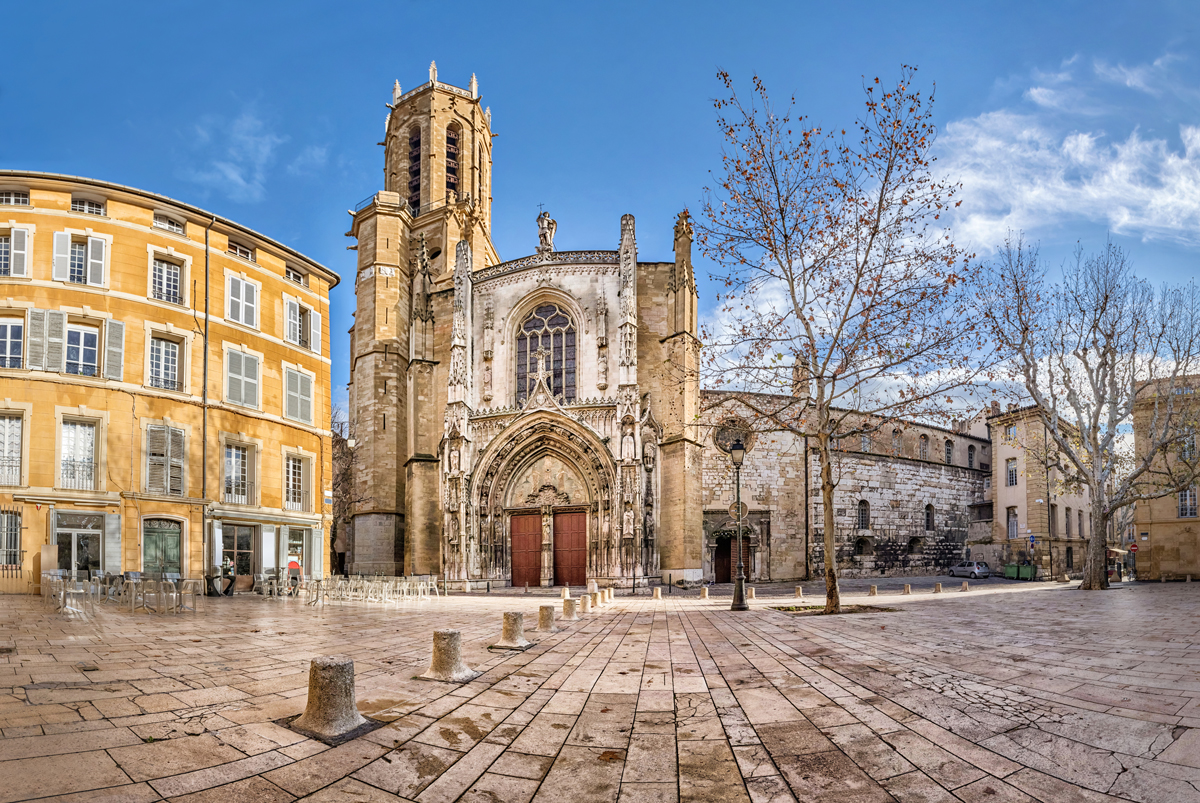
The construction of the cathedral
The first construction of a Christian sanctuary dates from around 500 AD with a small oratory “The Saviour’s Transfiguration”. The church was later enlarged by Bishop Basilius due to the increasing number of believers. The new church comprised a group of episcopal buildings including a chapel, a baptistery and other rooms.
In 731, the Saracens destroyed the city of Aix as well as the church. The people of Aix rebuilt it in 1057 under Rostagnus, Bishop of Aix and Benedictus, the Cathedral Provost. The bishop dedicated the cathedral in 1103.
In addition, Benedictus built a cloister next to the cathedral where he established himself with other monks living under the rule of Saint Augustine.
The vast choir gallery was rebuilt in 1285. Moreover, following new extensions in the 14th century, a new Gothic nave was added to the original Romanesque nave. The latter was then relegated to a side aisle.
A new side aisle was added in the 17th century.
Finally, the cathedral underwent a major restoration in the 19th century. The high altar with two angels of gilded wood in the Empire style is an addition from 1805. Between 1857 and 1862, the nave was redecorated with painted and sculpted neo-Gothic elements.
My book recommendation!
Its name? Simply:
Gothic: Architecture, Sculpture, Painting by Rolf Toman, Publisher: Ullmann
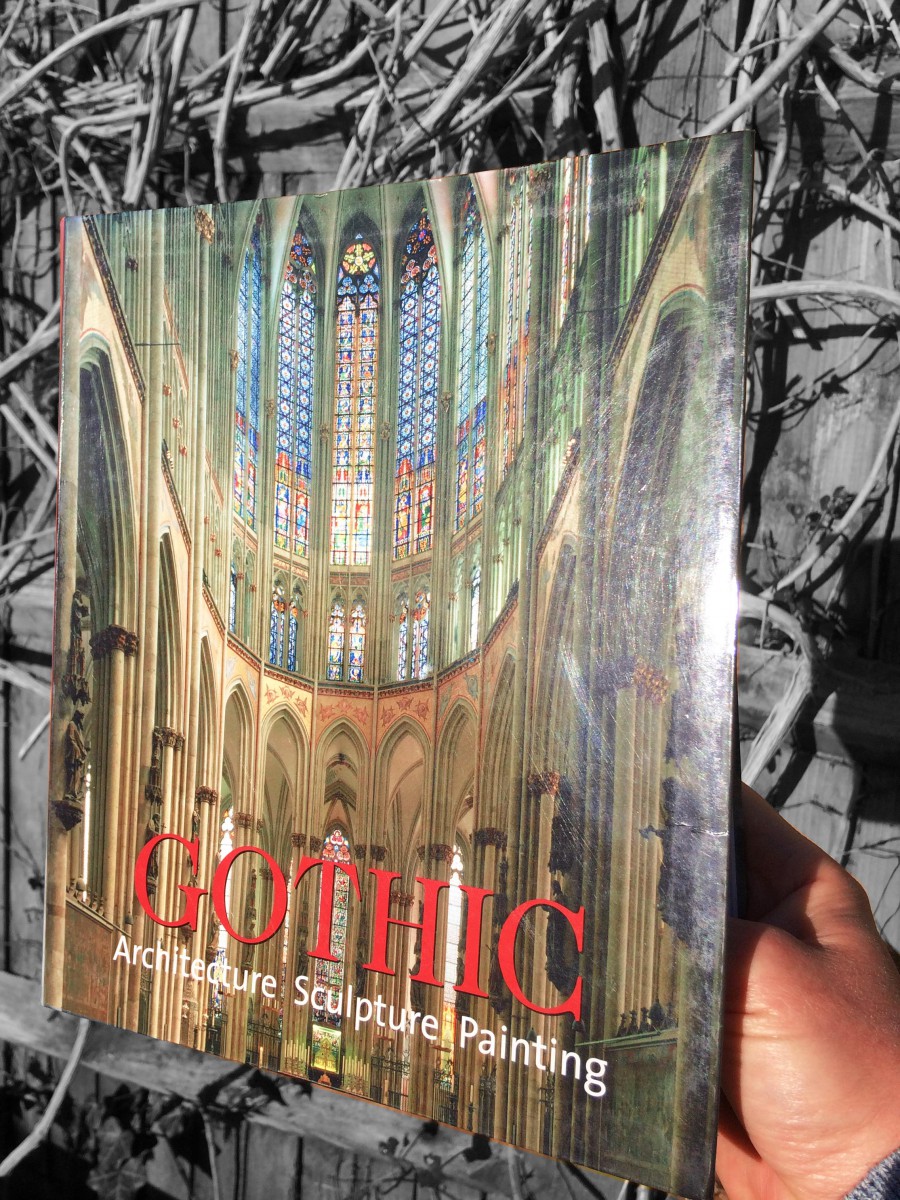
This book has been for me a great resource that helped me better understand the Gothic movement in art from the 12th century to the Renaissance. An architectural style that first originated in France and spread all over Europe.
Over 500 pages it focuses on the development of Gothic architecture with many illustrations and photographs, but not only. I’ve also found interesting the in-depth discussion of the most diverse art forms, including painting, sculpture, metalwork and even book illumination! It also includes specific coverage of the Cathars’ Heresy and the Papal Palace in Avignon. And, of course, it mentions the cathedral of Saint-Sauveur in Aix-en-Provence!
This is definitely the book I recommend if – like me – you love everything about Gothic such as churches, gargoyles, stained glass, flying buttresses and so much more.
The exterior of Aix Cathedral
Let’s have a closer look at the west front, the main façade of Aix-en-Provence cathedral.
The western façade with its flamboyant Gothic portals seems quite at odds in Provence. Indeed the region kept many churches and chapels in the Romanesque architectural style.
The buttresses are decorated with long and narrow niches surmounted with pinnacles. They serve to make the massive structure of the buttresses less visible.
The yellowish colour of the buttresses is contrasted with the central structure of the portal which was added later.
The Portal
The portal was built between 1476 and 1513 in Flamboyant Gothic style and stretches out to 46 metres. With the completion of the nave, attention was drawn to the unfinished western façade.
The cathedral’s Chapter commissioned the red doors in walnut in 1505.

Three tall statues representing the Apostles stand on each side of the door. The statues of the six remaining Apostles are found in the side buttresses to the right and to the left of the portal.
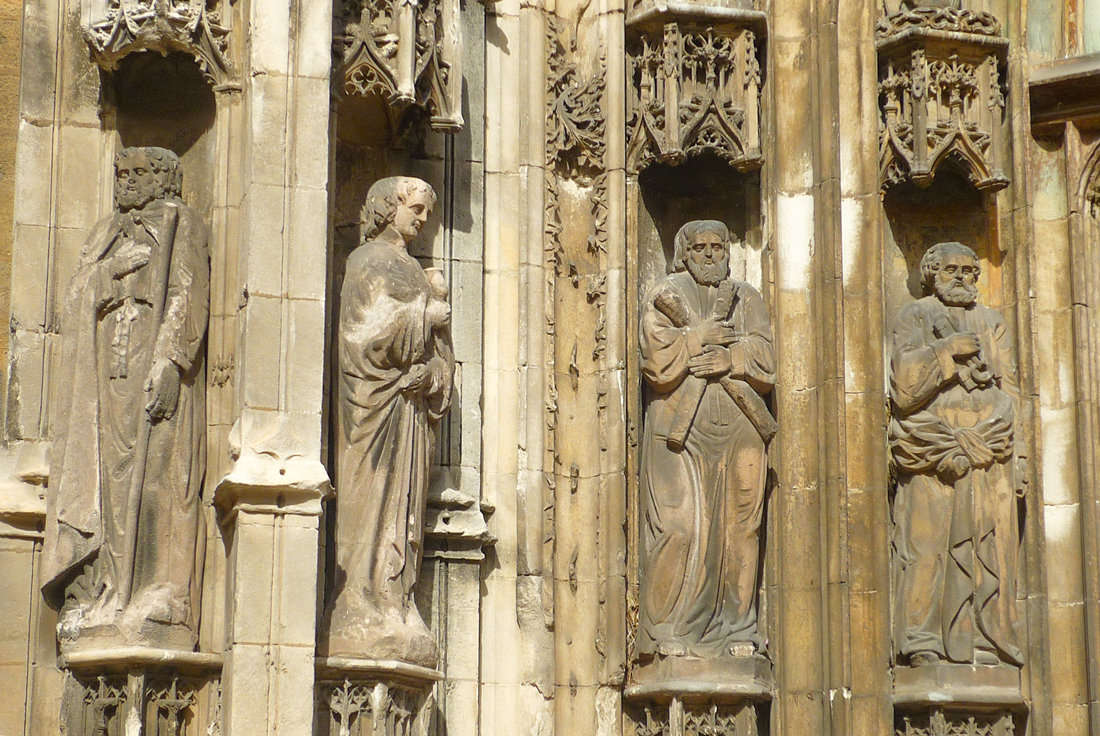
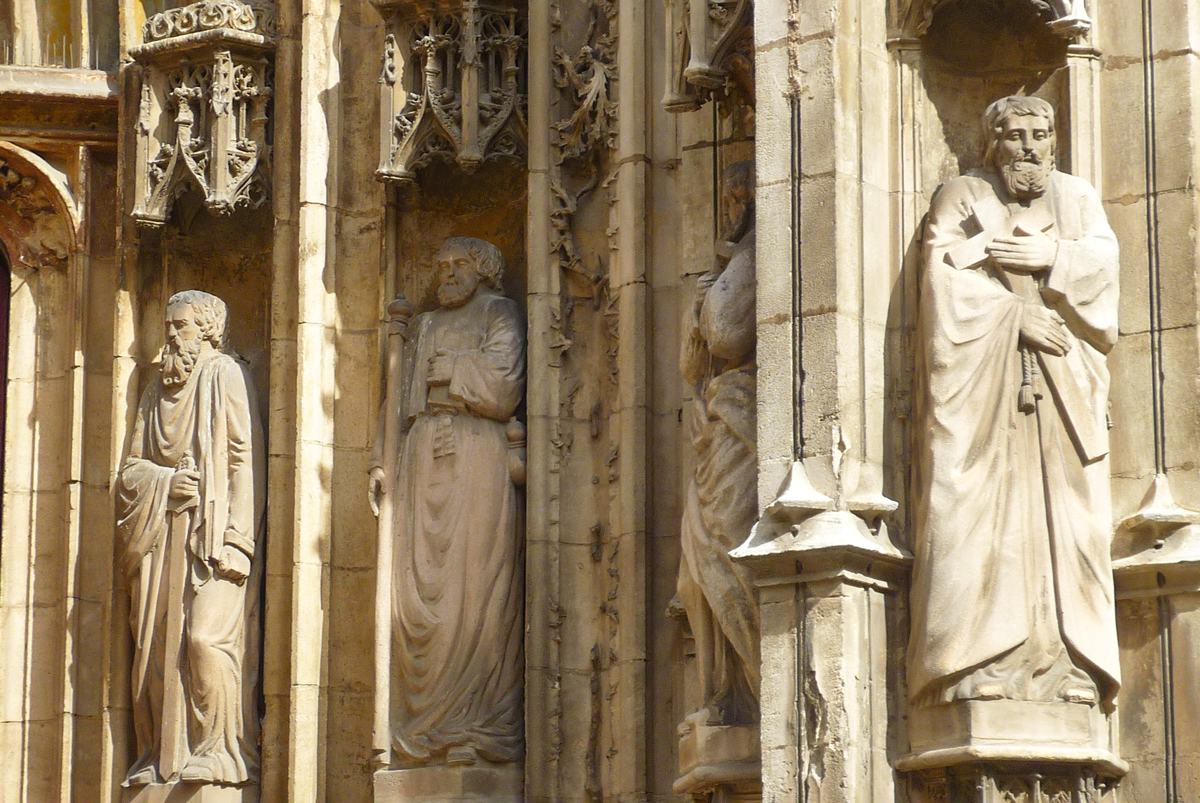
A Virgin and a Child statue decorates the central pillar between the two doors.
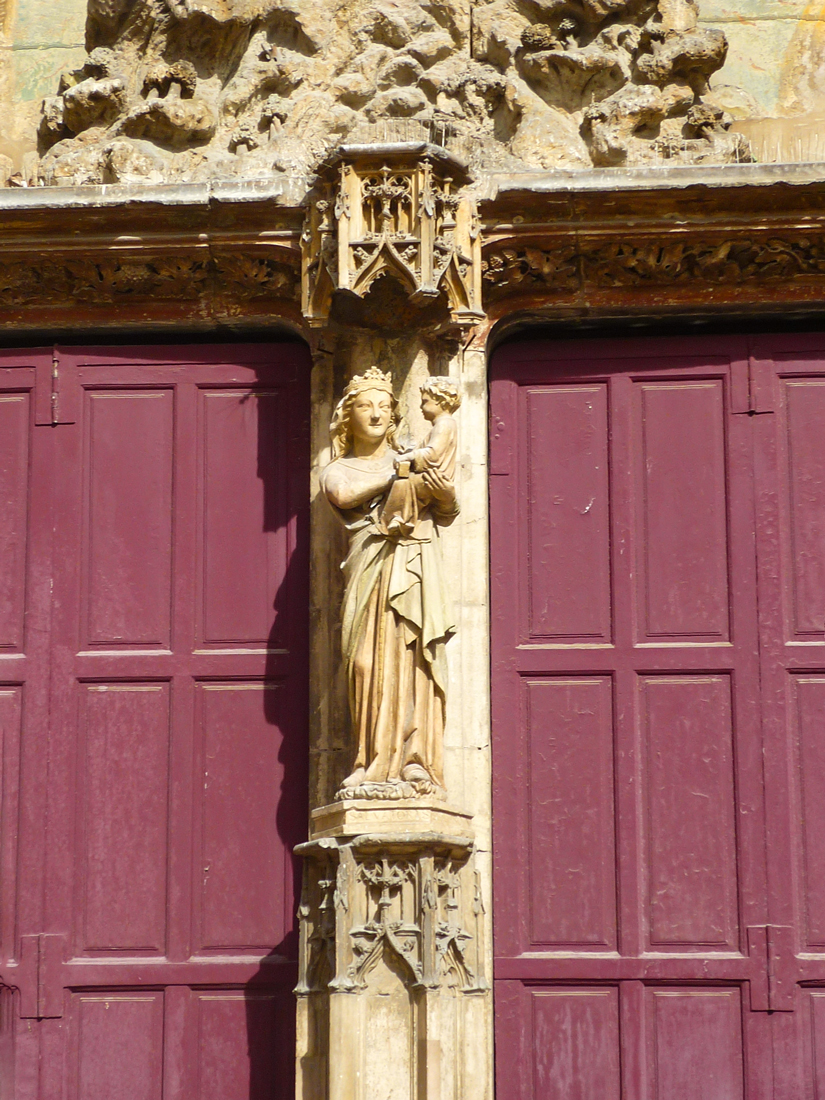
The tympanum
The French Revolution ruined the tympanum above the doors by destroying its original decorative panel comprising six statues. Traces of paint are still visible today as a reminder that in the Middle Ages, most Gothic portals were colourful.
Three archivolts close the tympanum:
- a ruined one,
- a frieze with ten bearded elders depicting the prophets of the Old Testament, and
- the last one representing angels.
The statues of the façade, believed to depict the kings of France, were beheaded and their original heads lost. They have since been replaced by those that you can see today.
The gable
A fine gable surmounts the two doors and the tympanum. Its two curved sides end in a shape evoking something like a curly cabbage.
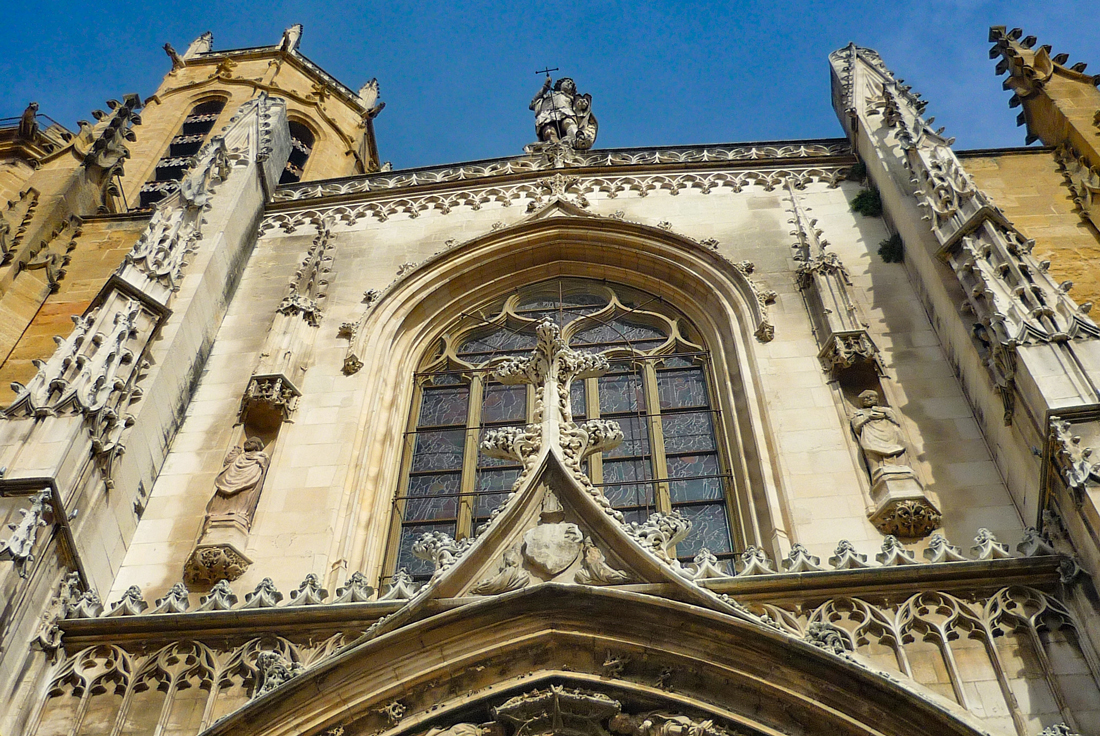
Above the main portals and the gable is a fine stained-glass window from the 19th century. It is flanked on each side by a statue.
The statue of archangel Michael
The façade ends with a Gothic balustrade on which stands a statue by Jean Paumier of Archangel Saint Michael (1507) slaying the dragon with a cross.
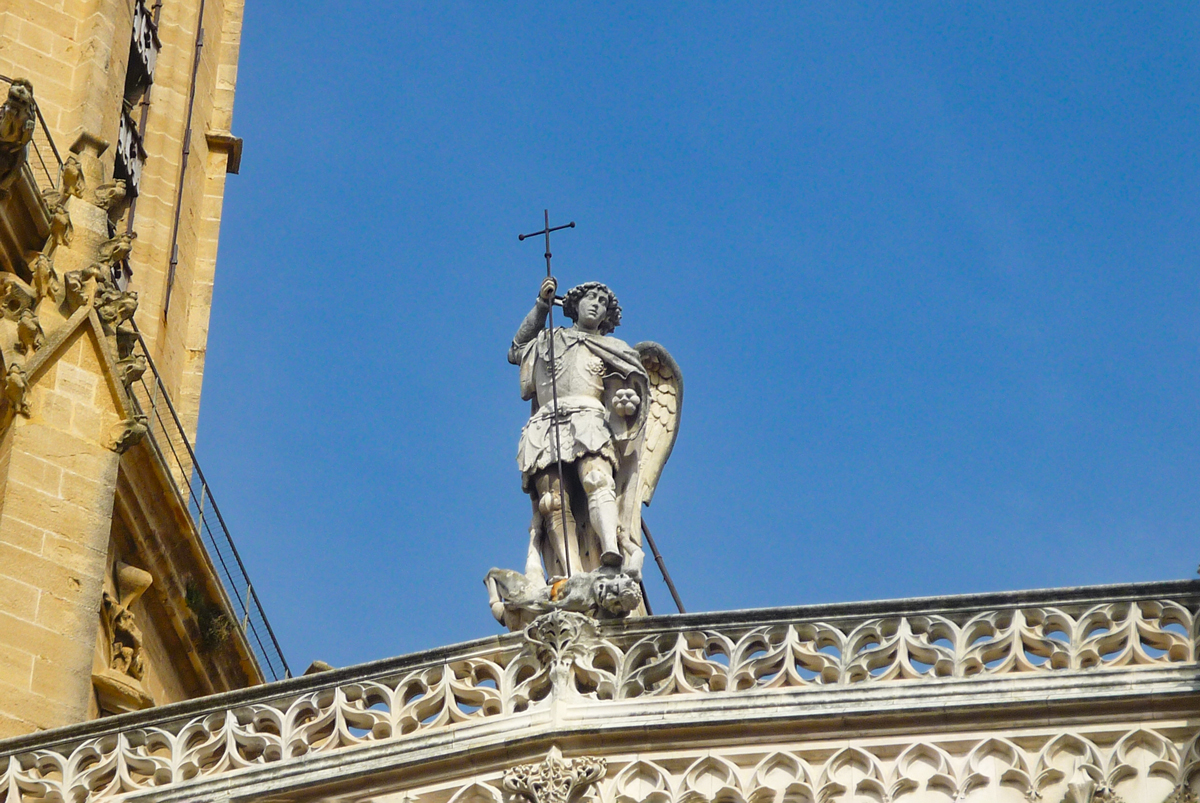
The Bell Tower
To the left of the 16th-century flamboyant façade rises a 64-metre high bell tower.
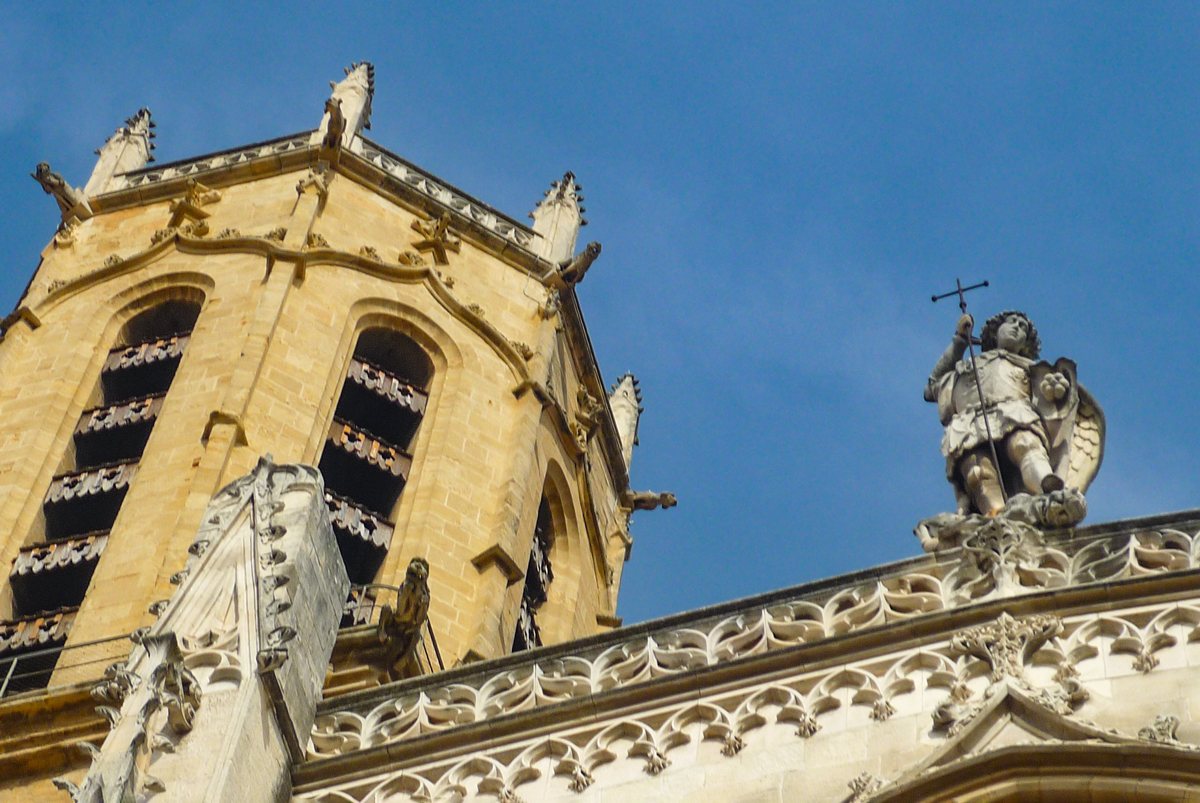
The foundation work of the tower started in 1323 under the direction of Pierre de Burle. After a suspension of nearly a century, works resumed in 1411 and took 14 years to complete.
The base of the bell tower has a squared shape that rises above the roof of the nave. It is surmounted by an octagonal tower interspersed with wide bays on each side. Bells were placed inside the octagonal tower in 1430.
For financial reasons, Aix Cathedral has only one tower (echoing the cathedrals of Strasbourg and Troyes) whereas a typical symmetrical Gothic cathedral should have at least two. The bell tower underwent restoration in the 19th century.

The interior of Aix Cathedral

The nave
The nave is 65.66 metres long and 12.60 metres wide.
The keystone rises to 20 metres, which is considerably lower than in other French Gothic cathedrals such as Amiens (42.3 m), Metz (41.77 m) or Chartres (37 m) cathedrals.
What makes the Aix-en-Provence cathedral very unusual is the presence of a triple nave:
- the Romanesque side aisle served as the main nave before the construction of the central nave,
- the Gothic central nave,
- the north aisle in the Baroque style from the 17th century.
![The Romanesque nave of Aix-en-Provence Cathedral © Bjs - licence [CC BY-SA 4.0] from Wikimedia Commons](https://frenchmoments.eu/wp-content/uploads/2013/04/Roman-nave-of-Aix-Cathedral-©-Bjs-licence-CC-BY-SA-4.0-from-Wikimedia-Commons-scaled.jpg)
![The Gothic nave of Aix-en-Provence Cathedral © Bjs - licence [CC BY-SA 4.0] from Wikimedia Commons](https://frenchmoments.eu/wp-content/uploads/2013/04/Nave-of-Aix-Cathedral-©-Bjs-licence-CC-BY-SA-4.0-from-Wikimedia-Commons-scaled.jpg)
![Aix-en-Provence Cathedral - Baroque Nave © Bjs - licence [CC BY-SA 4.0] from Wikimedia Commons](https://frenchmoments.eu/wp-content/uploads/2013/04/Baroque-Nave-Aix-Cathedral-©-Bjs-licence-CC-BY-SA-4.0-from-Wikimedia-Commons-scaled.jpg)
The Choir Gallery
In the choir, look for the cathedra, the seat (or throne) of the bishop of Aix-en-Provence.
![Choir of Aix-en-Provence Cathedral © MatthiasKabel - licence [CC BY-SA 3.0] from Wikimedia Commons](https://frenchmoments.eu/wp-content/uploads/2013/04/Aix-Cathedral-©-MatthiasKabel-licence-CC-BY-SA-3.0-from-Wikimedia-Commons-scaled.jpg)
This modern sculpture features a wavy bronze panel which evokes “God’s breathing in of His own life’s breath in the form of the Holy Spirit to fill the great sail as it surrounds the movements of the waves of life”.
The altar represents the Holy Trinity by resting on three bronze shapes.
The Baptistery Rotunda
The oldest part of the cathedral is the baptistery from the 5th or 6th century. It is also one of the oldest in France along with those in Riez and Fréjus.
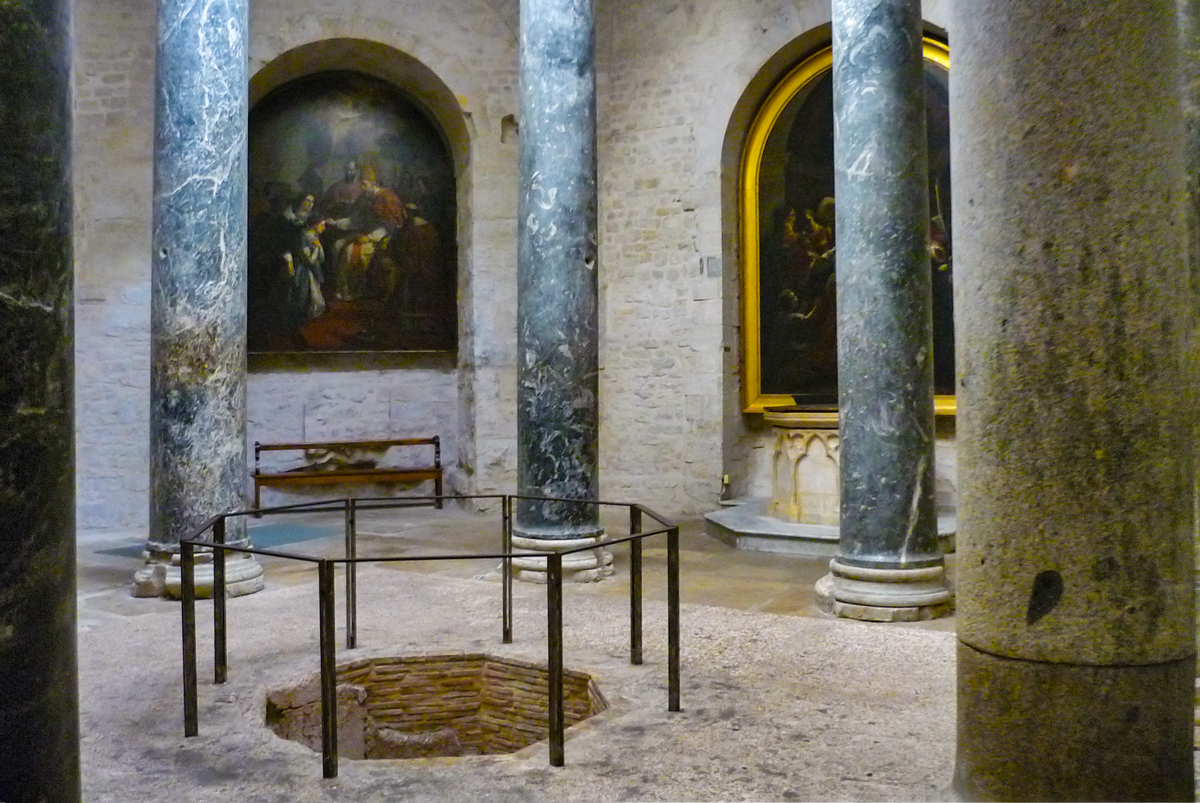
The rotunda of the baptistery forms a circle of eight Roman-origin columns, including two made from granite and six made from cipollino marble. Their capitals and bases are made from white marble. These Corinthian columns were part of the Roman temple dedicated to Apollo which stood there during the Roman era.
The basin dates back to the Merovingian era. It has an octagonal shape which is a symbol of regeneration. Originally, the water came from the Roman Thermae.
Under the flagstones are found the vaults of local canons and archbishops.
On one wall, some stones have been removed to reveal a Romanesque fresco.
The beautiful cupola of the baptistery (1579) is a gift of Canon Jean de Leone. It features fine plaster works and decoration known in French as “gypseries”.
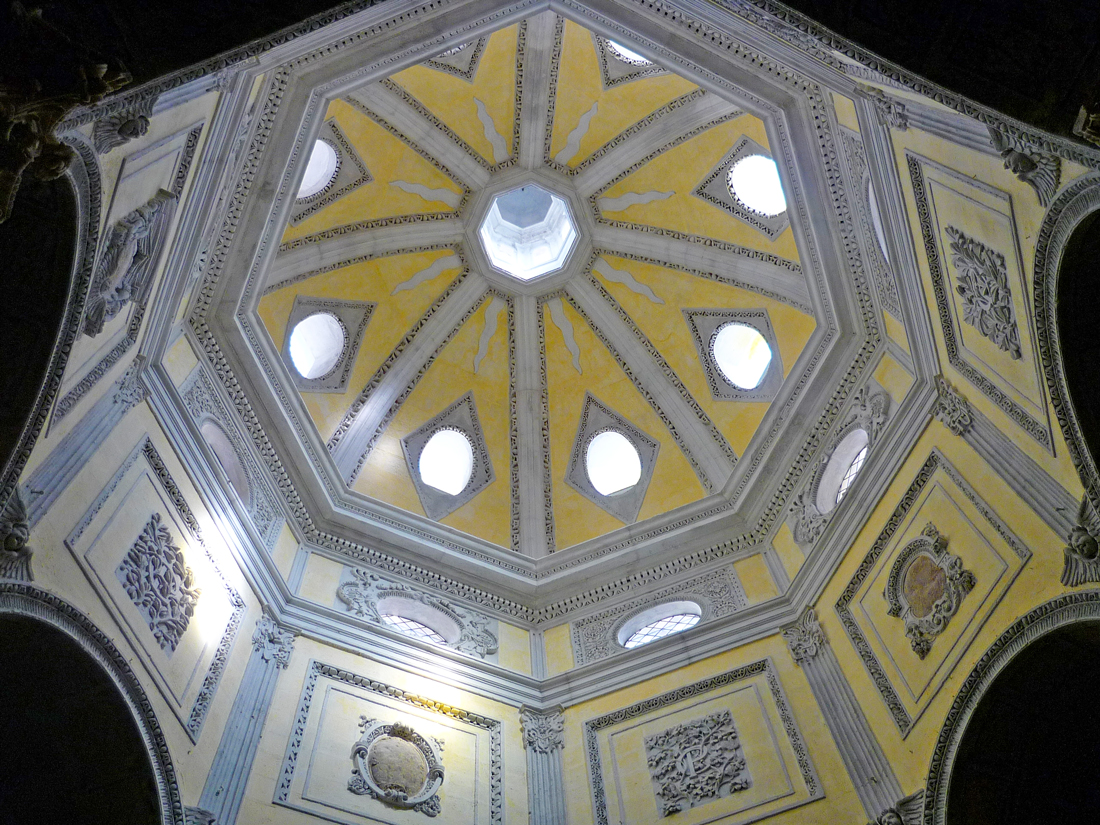
The St. Côme and Damien Chapel
![Sarcophagus of Saint-Mitre © Bjs - licence [CC BY-SA 4.0] from Wikimedia Commons](https://frenchmoments.eu/wp-content/uploads/2013/04/Sarcophagis-Aix-Cathedral-©-Bjs-licence-CC-BY-SA-4.0-from-Wikimedia-Commons-scaled.jpg)
Built towards the end of the 16th century, the chapel serves as a narthex of the baptistery. It contains a marble sarcophagus from the 6th century believed to be that of Saint Mitre.
In the chapel, you can see sections of the Roman pavement of the East Cardo (a street perpendicular to the Decumanus of the Roman Forum).
![Part of the Cardo - Cathedral of Aix © Malost - licence [CC BY-SA 3.0] from Wikimedia Commons](https://frenchmoments.eu/wp-content/uploads/2013/04/Cardo-Aix-Cathedral-©-Malost-licence-CC-BY-SA-3.0-from-Wikimedia-Commons-scaled.jpg)
The Chancel Organ
Located on the Gospel wall of the chancel, the remarkable “green and gold” organ case is in the Louis XV style and made of pine. Dating back to 1745, it received its instrument in 1855. It features 38 stops over 3 manuals and pedals.
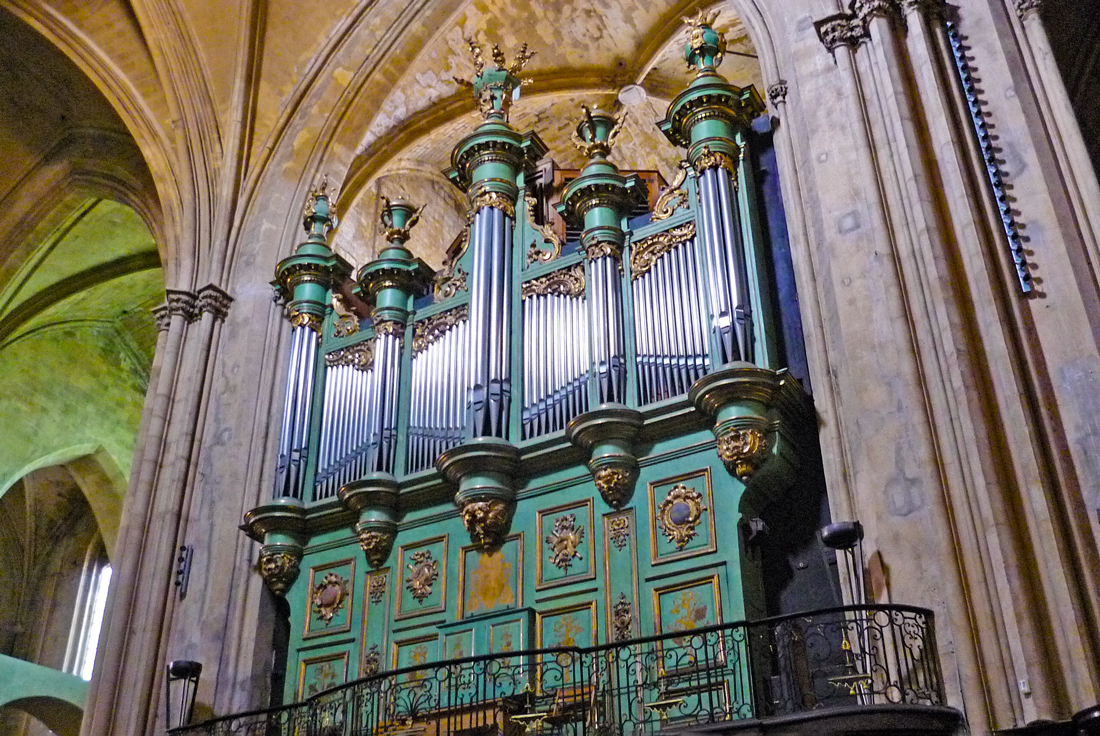
For esthetic reasons, an identical organ case was added on the opposite side – the Epistle Wall – to face each other. This addition is a fake organ: although its organ case is identical in its layout and features with the same painted and sculpted decoration, it is to this day empty!
The Burning Bush Triptych of Nicolas Froment
The triptych of the Burning Bush is arguable the most valuable work in the Aix-en-Provence cathedral. You can admire it in St. Lazarus Chapel.

King René commissioned the painting to Nicolas Froment from Avignon om 1475-1476. Many consider it one of Europe’s most beautiful 15th-century paintings. The triptych shows a representation of the Burning Bush from the book of Exodus in the Bible.
- The central part shows an angel (left) and Moses guarding his flock (right) amazed by the vision of the burning bush on which are seated a Virgin and Child.
- The two other parts of the masterpiece depict the art patrons, King René and Queen Jeanne, kneeling in adoration.
The painting was designed for the funerary chapel of King René in the Grands-Carmes church in Aix. It was moved inside the cathedral in the 19th century.
Although the triptych has recently been restored, it remains fragile. Visitors can only view it wide open on specific days.
The Aygosis altar
The Autel des Aygosi is a stone altar which originally belonged to the Carmelite church. It was transferred to Aix-en-Provence cathedral in 1823.
![Autel des Aygosi Aix Cathedral © Jmdesbois - licence [CC BY-SA 3.0] from Wikimedia Commons](https://frenchmoments.eu/wp-content/uploads/2013/04/Autel-des-Aygosi-Aix-Cathedral-©-Jmdesbois-licence-CC-BY-SA-3.0-from-Wikimedia-Commons.jpg)
“Anne, the glorious mother of the Virgin Mary is venerated in the present chapel. Nobleman Urbain Aygosi has exhibited here the height of love. In the present year of the Lord 1470, the chapel is completed by the grace of God on the 28th of January.”
The monument includes :
- an altar surmounted by a false tabernacle, with the arms of Urban Aygosi at its ends.
- a tabernacle decorated with a Christ statue bearing the inscription: “See, mortal, it is for you that such a victim is given up“.
- a stone altarpiece with six figures: in the centre, Saint Anne, in front of her the Virgin, in her arms the infant Jesus. On the left is St. Maurice in a 15th-century armour, on the right St. Margaret rising from the dragon. Finally, Christ on the cross dominates the altarpiece.
- On either side of the altar were statues of the Virgin and St John, now on display in the Musée Granet.
The sculptor of this altar, Audinet Stéphani, was originally from the diocese of Cambrai and worked in Aix and its region between 1446 and 1476.
Sacred Heart Chapel
The Sacred Heart chapel in the Romanesque side aisle features a stained-glass window by the Didron workshop (1866): “Vitrail des anges musiciens et des saints de Provence” (musician angels and saints of Provence).
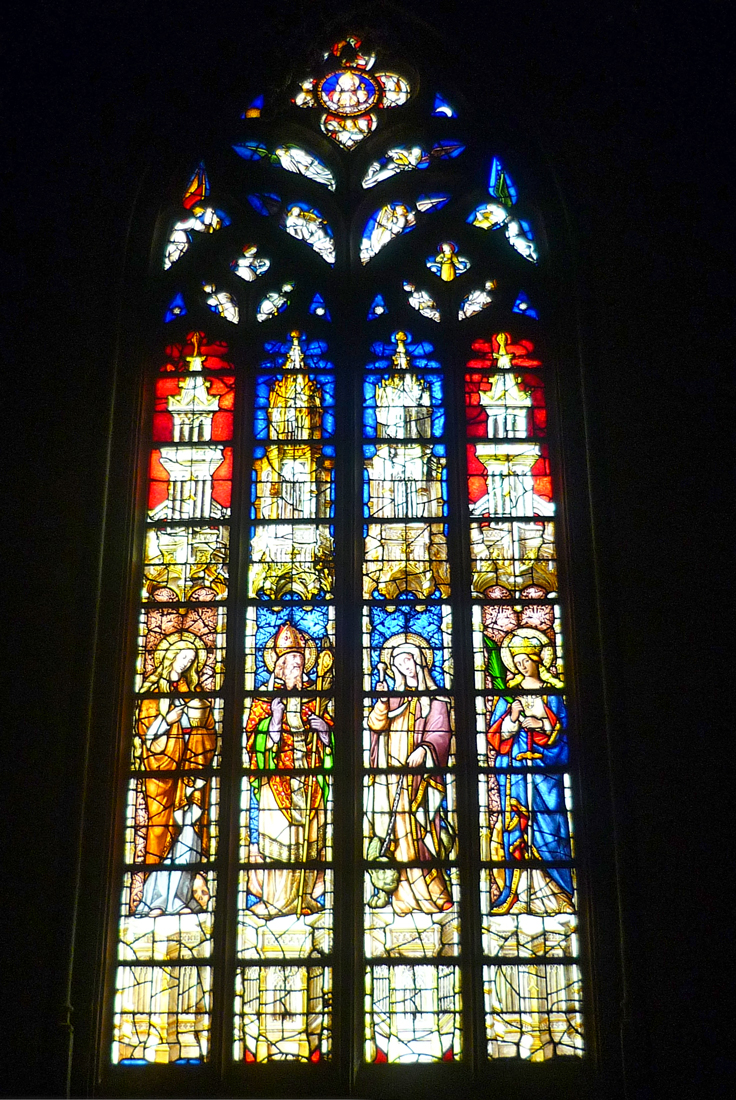
The Cloister
The 12th-century Romanesque cloister on the south side occupies the site of an old Roman square believed to date from the 1st century AD.
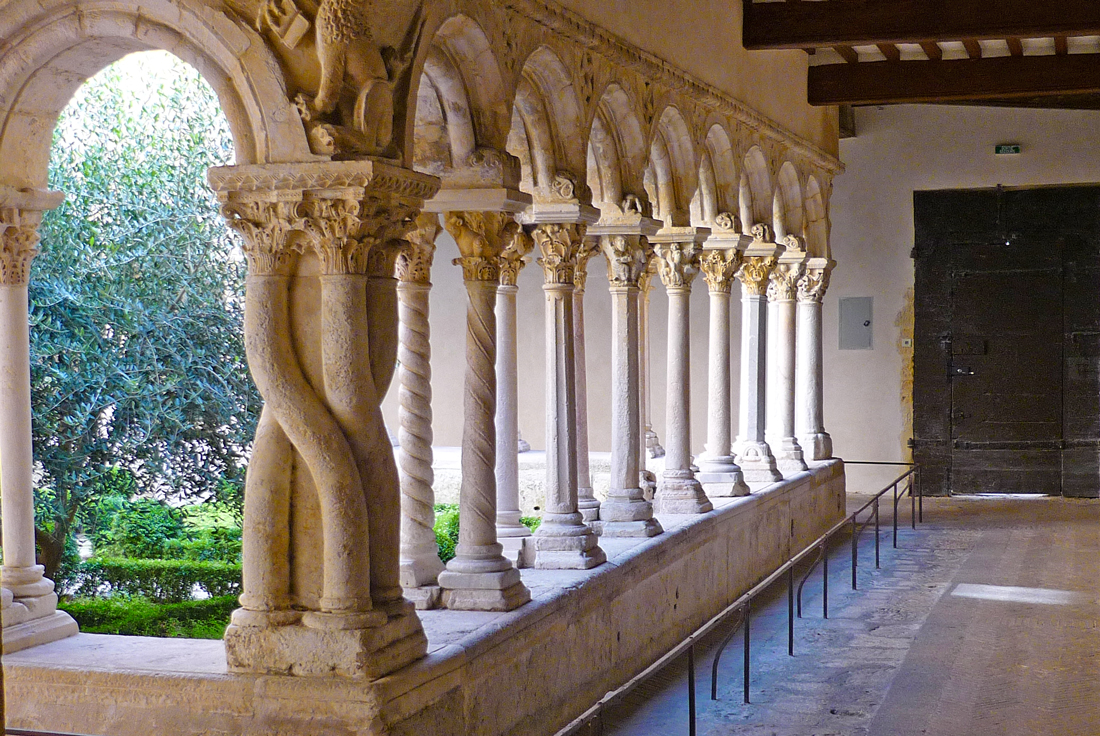
The galleries have slender columns overlooking a squared garden. The carved capitals show biblical scenes and symbols such as plants and animals.
The four angles of the cloister are each decorated with carvings symbolising the four evangelists:
- an angel (Matthew),
- a lion (Mark),
- an eagle (John), and
- a bull (Luke).
The dimensions of the cloister are quite small. Notice the timber ceilings of the galleries.
Pin Aix-en-Provence Cathedral for later!
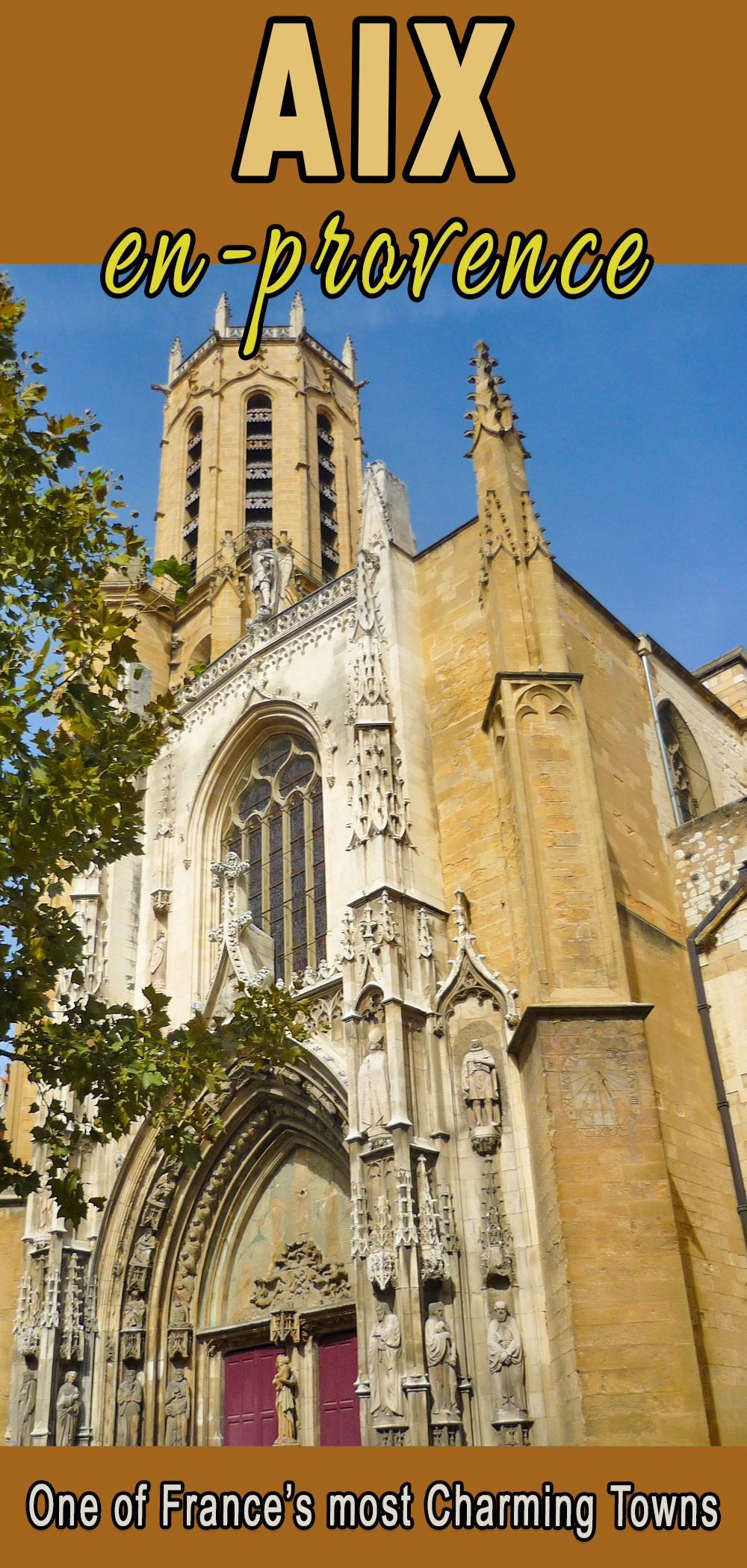

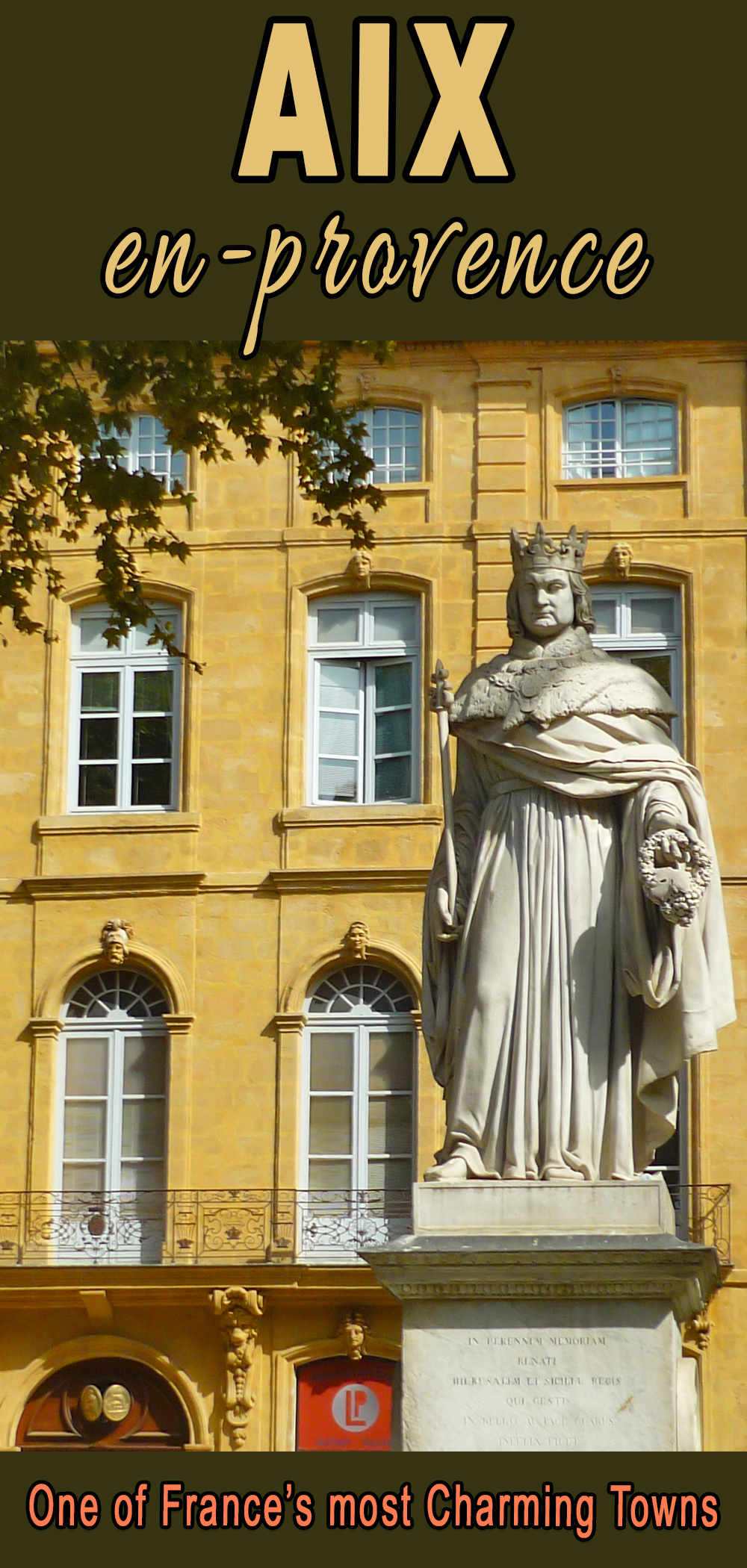
Aix-en-Provence: Find out more!
All our pages about Aix-en-Provence on the blog:
- Practical info for planning your visit to Aix-en-Provence
- Aix-en-Provence Old Town: A Discovery Guide
- Aix-en-Provence History: A Brief Account
- Cours Mirabeau, Aix-en-Provence
- Place de l’Hôtel de Ville of Aix-en-Provence
- Place d’Albertas: an elegant square in Aix-en-Provence
- The Calissons of Aix: a Specialty Candy from Provence
- Montagne Sainte-Victoire: the iconic mountain of Aix
- Around Aix-en-Provence: 10 Beautiful Places to Visit
More info about Aix-en-Provence:
- Discover the historic and cultural region of Provence on the blog
- Visit the Tourist office board of Aix-en-Provence
- Read more about Aix-en-Provence old town on Wikipedia
- Book your accommodation in Aix-en-Provence
- If you fancy discovering another ancient church in Provence, check out our article on the Apt Cathedral in the Luberon.

Where to stay in Aix-en-Provence?
You can choose from a great range of accommodation in Aix-en-Provence, from hotels to B&B and campings! My recommendation is to book your accommodation near the city centre. Although it’s a more pricey option, you’ll save time on transportation and can access most of the 10 things to see within walking distance.
Also, when possible, don’t wait until the last minute to book as finding hotel rooms can be a problem, especially on weekdays.
To book your accommodation in Aix, click on this affiliate link which will redirect you to our partner booking.com… or use the interactive map below:
Things to do in Aix-en-Provence
Looking for activities and things to do in Aix-en-Provence old town and its surroundings? Check out the offers from our partner Get Your Guide:
Featured image: Aix-en-Provence Cathedral. Photo by bbsferrari via Envato Elements




